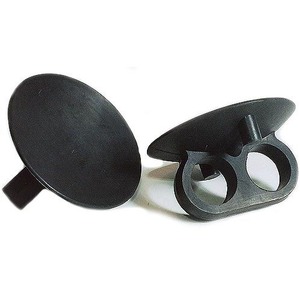These simple versions of the original Magdeburg Hemispheres can be used for a great vacuum demonstration. You simply press the two hemispheres together, squeezing all the air out of the middle gap, and then try to separate them. It takes a huge force to do that! What is holding the hemispheres together? Just AIR!
Makes a wonderful class demonstration or a start to a great science fair project!
Features:
- Two hemispheres included, each 3.25 inches (83mm) in diameter
- Hemispheres measure 3.25in (8.26cm) in diameter
- Demonstrates a vacuum
- Can be done alone or with a friend
About the Original Magdeburg Hemispheres
The Magdeburg hemispheres were a pair of large copper hemispheres with mating rims. When the rims were sealed with grease and the air was pumped out, the sphere contained a vacuum and could not be pulled apart by teams of horses. The Magdeburg hemispheres were designed by German scientist and mayor of Magdeburg, Otto von Guericke in 1650 to demonstrate the air pump he had invented and the concept of air pressure. The first artificial vacuum had been produced a few years earlier by Evangelista Torricelli, and had inspired von Guericke to design the world’s first vacuum pump, which consisted of a piston and cylinder with one-way flap valves. The original hemispheres are preserved in the Deutsches Museum in Munich.
Overview
The Magdeburg hemispheres, around 50 cm (20 inches) in diameter, were designed to demonstrate the vacuum pump that von Guericke had invented. One of them had a tube connection to attach the pump, with a valve to close it off. When the air was sucked out from inside the hemispheres, and the valve was closed, the hose from the pump could be detached, and they were held firmly together by the air pressure of the surrounding atmosphere.
The force holding the hemispheres together was equal to the area bounded by the joint between the hemispheres, a circle with a diameter of 50 cm, multiplied by the difference in air pressure between the inside and the outside. It is unclear how good a vacuum von Guericke’s pump was able to achieve, but if it was able to evacuate all of the air from the inside, the hemispheres would have been held together with a force of around 20 000 N (4 500 lbf), equivalent to lifting a car or small elephant; a dramatic demonstration of the pressure of the atmosphere.
Von Guericke’s demonstration was performed on 8 May 1654 in front of the Reichstag and the Emperor Ferdinand III in Regensburg. Thirty horses, in two teams of 15, could not separate the hemispheres until the vacuum was released. In 1656 he repeated the demonstration with 16 horses (2 teams of 8) in his hometown of Magdeburg, where he was mayor. He also took the two spheres, hung the two hemispheres with a support, and removed the air from within. He then strapped weights to the spheres, but the spheres would not budge. In 1657, Gaspar Schott was the first to describe the experiment in print in his Mechanica Hydraulico-Pneumatica. In 1663 (or according to some sources in 1661) the demonstration was given in Berlin before Frederick William, Elector of Brandenburg) with 24 horses.
The experiment became very popular to illustrate the principles of air pressure, and many smaller copies of the hemispheres were made, and are used to this day in science classes. Re-enactments of von Guerike’s 1654 experiment are performed in locations around the world by the Otto von Guericke Society. The experiment has been commemorated on at least two German stamps.
Information courtesy of Wikipedia.
13 +
4.25 x 3.25 x 3.25 inches
10.80cm x 8.26cm x 8.26cm
0 lb 3 oz
0.07 kg
 WARNING: This product can expose you to chemicals which are known to the State of California to cause cancer. For more information, go to www.P65Warnings.ca.gov.
WARNING: This product can expose you to chemicals which are known to the State of California to cause cancer. For more information, go to www.P65Warnings.ca.gov.
Customer Reviews
 Magdeburg Hemispheres
Magdeburg HemispheresThad Johnson from Rochester Hills, MI
These things are great! Incredible way to demonstrate the incredible power of air pressure surrounding us. They work fantastic and are easy to take along and have fun with. It puts the fun back in learning!
 Easy way to teach an important priciple
Easy way to teach an important pricipleJerry from Olney, MD
This is a simple pair of injection-molded rubber suction cups, roughly 4" diameter, which can be used individually or together to demonstrate the enormous forces generated by atmospheric pressure. Wetting the face of the cups is advisable to achieve a more robust airtight seal prior to use.












